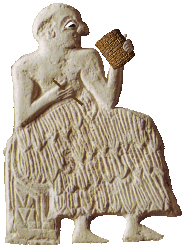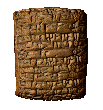or 3500 years ancient Mesopotamian scribes pressed their reed styluses into damp clay and generated millions of cuneiform texts in various Ancient Near East languages. The earliest written documents in Mesopotamia appear around 3400 B.C., and the last known native cuneiform tablet was written in 75 A.D. Cuneiform text genres include everything from ephemera to literary masterpieces, from medical treatises to historical texts, mathematical and grammatical exercises, beer recipes, international treaties, musical scores, legal codes, religious rituals, sales receipts, maps, and astronomical tables.
Because sun-dried or fired clay tablets are reasonably durable, they have been preserved in the sands of the Near East for millennia, and museums around the world have acquired approximately 400,000 tablets,
 34th Century B.C.with thousands being unearthed every year. Cuneiform scholars continue to make unique and valuable contributions to the study of history, law, religion, linguistics, mathematics, and science. The vast majority of cuneiform tablets come from ancient Mesopotamia, modern Iraq, and recent events in Iraq have only underscored the vulnerability of Iraq’s, indeed the world's, ancient cultural heritage. Now, for the first time in history, utilizing technologies developed and invented over the last eight years by the Digital Hammurabi Project at Johns Hopkins University, we are poised to digitally archive, publish, and research high-quality, 3D images of the world’s oldest written documents.
34th Century B.C.with thousands being unearthed every year. Cuneiform scholars continue to make unique and valuable contributions to the study of history, law, religion, linguistics, mathematics, and science. The vast majority of cuneiform tablets come from ancient Mesopotamia, modern Iraq, and recent events in Iraq have only underscored the vulnerability of Iraq’s, indeed the world's, ancient cultural heritage. Now, for the first time in history, utilizing technologies developed and invented over the last eight years by the Digital Hammurabi Project at Johns Hopkins University, we are poised to digitally archive, publish, and research high-quality, 3D images of the world’s oldest written documents.
Since 1999 the Digital Hammurabi Project at Johns Hopkins University has pioneered basic research on digitizing ancient cuneiform tablets, the world’s oldest written documents. In the 150 years since the decipherment of Babylonian cuneiform only about 1/10th of the known cuneiform tablets have been read by modern humans. There are several reasons for this, but three of them are associated with problems that have technological solutions:

 21st Century A.D.
21st Century A.D.
1) there has been no standard computer encoding for cuneiform text; 2) the tablets are scattered in collections around the world, making for expensive, time-consuming, and, at times, difficult access; 3) due to cuneiform’s multi-tiered three-dimensionality (pillow-shaped tablets, wedges pressed into damp clay, and writing that runs onto all edges of a tablet) 2D photography is inadequate for archiving or editing cuneiform tablets. To this day cuneiformists still rely on hand copying the tablets, a very labor-intensive, time-consuming, subjective, and error-prone process.
Scientists, professors, engineers, students, and staff members at Johns Hopkins Applied Physics Laboratory, Whiting School of Engineering, and Krieger School of Arts & Sciences have developed and invented world class hardware and software tools for three-dimensional scanning, visualization, and text entry of cuneiform tablets, the foundational documents of world history and world culture.
Funded in large part by a 4-year, $1.65 million U.S. National Science Foundation grant in 2002, the Digital Hammurbi team has invented a 3D surface scanner that scans cuneiform tablets at 4 times the resolution of any comparable technology (over 900 dots per inch). We have developed computer algorithms uniquely tailored for cuneiform tablet reconstruction and 3D visualization. And we have successfully overseen the adoption into Unicode of the first international standard for the representation of cuneiform text on computers.
These enabling technologies will revolutionize cuneiform studies. With high-resolution 3D scans we have, for the first time in history, archival-quality representations of cuneiform tablets, allowing us to preserve them faithfully, and to protect them digitally from vandalism, erosion, and careless handling. We can print 3D plastic models of tablets; we can digitally flatten them for 2D print publication; we can visualize them in new ways; we can digitally manipulate cuneiform text, and finally, we can publish 3D virtual tablets to anyone, anywhere in the world, over the Internet.







